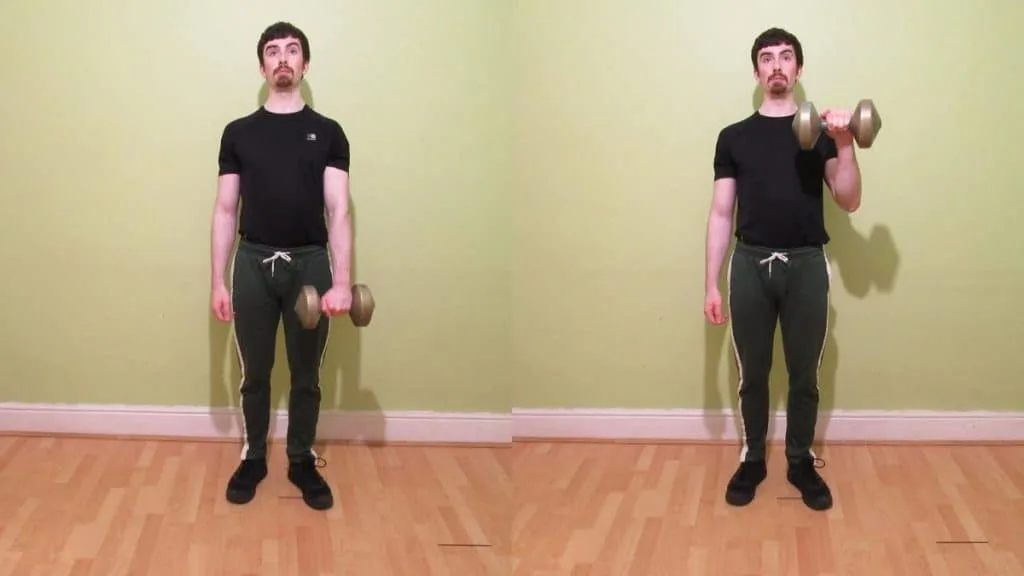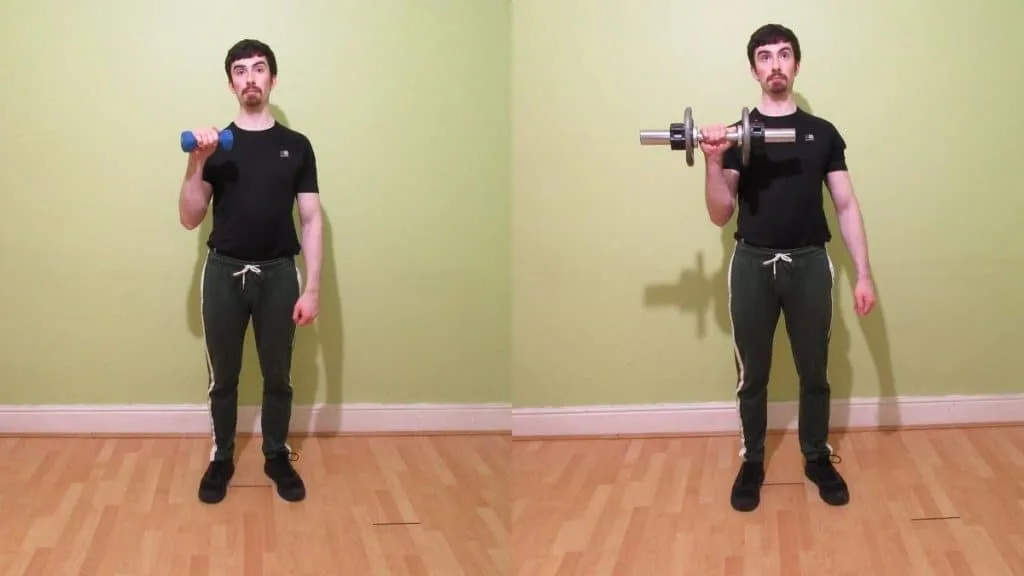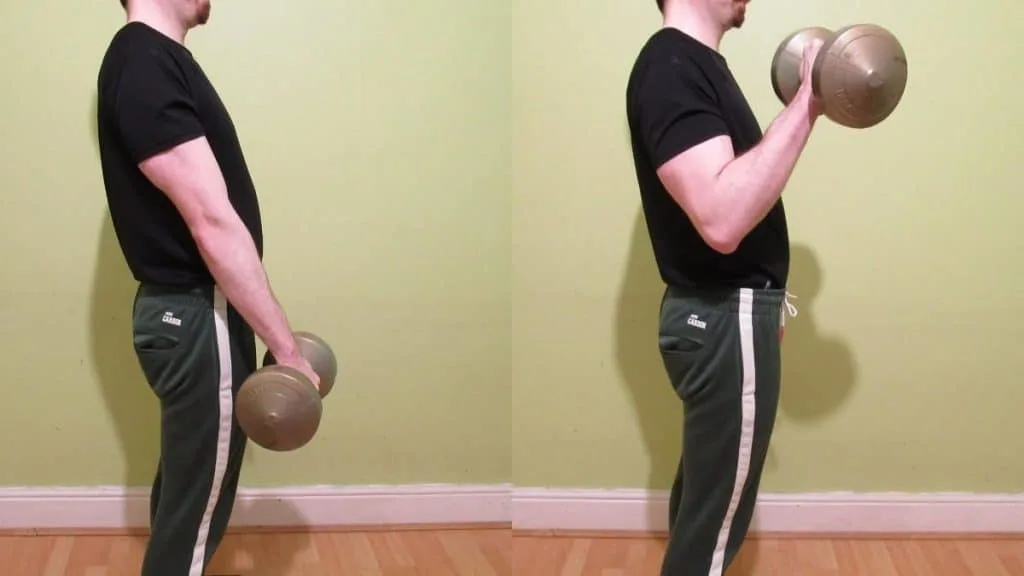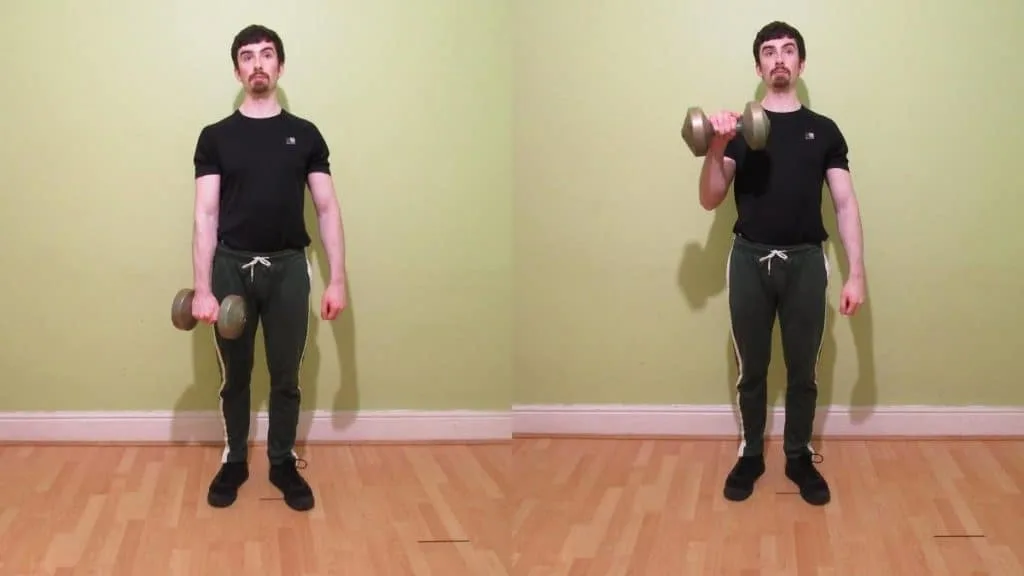The primary biceps function besides elbow flexion is forearm supination. Therefore, by taking the biceps out of supination and thus placing them in a weaker position, you can shift the emphasis of a curl onto your brachialis and brachioradialis muscles.
Reverse grip barbell curls are the obvious choice in this regard. However, barbell-based exercises like this can often lead to muscular imbalances and an unsymmetrical physique. This is because there’s always a chance that your stronger arm will lift more of the weight than your weaker arm.
The solution is to perform the single arm reverse curl instead. Although you’ll have to lift lighter weights on this variation, the movement is highly effective for sculpting a proportional body because it helps ensure that both of your arms are getting equal stimulation.
Single arm reverse curl exercise details
- Also Known As: Single arm overhand curl, single arm pronated curl
- Main Muscles: Brachioradialis, brachialis, biceps brachii
- Secondary Muscles: Forearm extensors
- Exercise Type: Strength
- Exercise Mechanics: Isolation
- Difficulty Level: Beginner
- Equipment Needed: Dumbbells
How to do single arm reverse curls
- Hold a dumbbell with an overhand grip and stand up straight.
- With the dumbbell by your side, curl it toward your front delt by moving your forearm toward your biceps.
- Keep lifting until the tops of your forearms make contact with your biceps.
- Squeeze your arms and then lower the weight under control until your elbow is completely locked out.
- Repeat for 3-4 sets of 8-15 reps.
One arm reverse curl training tips
One arm dumbbell reverse curls are a straightforward exercise that you can perform virtually anywhere because all you need is a single dumbbell. However, in order to achieve the best results, it’s important to make a few tweaks to the movement.
Train your weakest arm first

The reason why exercises like the pronated concentration curl are so effective is that they build proportional muscles as well as large muscles. This helps your physique to flow better and improves your overall aesthetics.
However, if your weaker arm is noticeably lagging behind your stronger arm in size and/or strength, then you definitely want to train the weaker side first, which is to say, when you’re freshest. This way, you’ll be able to put the most amount of effort into bringing up your lagging arm and building a better upper body.
Just make sure to pin your elbow to your side and then keep it completely still while performing the one arm reverse curl. Doing so enables you to keep the tension on the target muscles and achieve a more potent muscle growth stimulus.
You can also try doing hammer curls one at a time if you want an exercise that enables you to lift heavier and which is also a bit more bicep-focused.
Perform high and low reps

As in a pronated grip spider curl, the primary muscles worked during a single arm reverse grip bicep curl are the brachialis and the brachioradialis.
The problem, if you can call it that, is that the brachialis responds best to high reps and slow negatives (because it’s a slow-twitch muscle), whereas the brachioradialis grows better from explosive low rep training.
Therefore, in order to get the best results, it’s recommended to perform a mixture of reps. The most effective way to do this is to start out heavy when you’re naturally at you’re strongest. Then, after a few low rep sets, decrease the resistance and bump up your reps to focus on the brachialis.
This approach is good practice in general, seen as every muscle has a mixture of fast and slow-twitch muscle fibers. However, it’s of particular importance for one arm reverse curls because they work two very different types of muscles.
To focus purely on your biceps, give one arm spider curls a try if you have access to a bench. They really pump up your biceps by emphasizing the peak contraction.
Use a thumbless grip

Why use a thumbless grip?
Well, let me tell you what happens when you don’t use a thumbless grip.
By wrapping your thumb around the dumbbell handle, you’re allowing the weight to rest in your hands.
However, by using a thumbless grip and keeping your thumb on the same side as your fingers, your forearm extensors and brachioradialis have to work much harder to hold the weight.
Ultimately, this small modification, which also applies to the reverse incline curl, dramatically increases muscle activation levels while helping you build a firmer grip in the process.
In conclusion

The single arm reverse curl is by no means a popular exercise. However, this doesn’t mean that it’s not effective. In fact, when you break the drill down (like we just did), you begin to realize that it’s actually a fantastic muscle-building movement.
Not only are single arm reverse curls convenient, which is ideal if you lift at home, but they also help you to build a more aesthetic physique. This is because it’s easier to ensure that both sides of your body are receiving equal work when you’re lifting the dumbbells independently.

